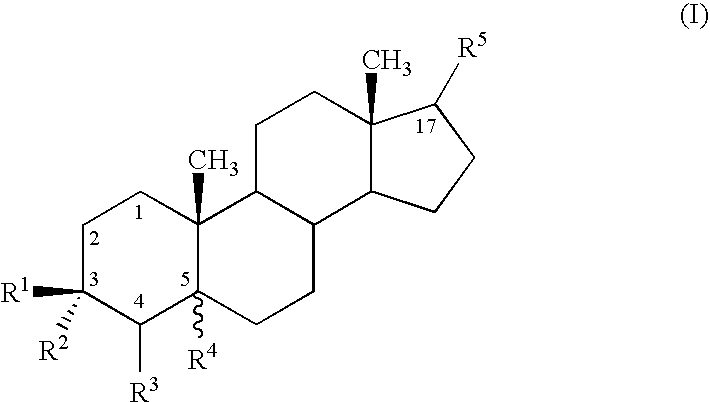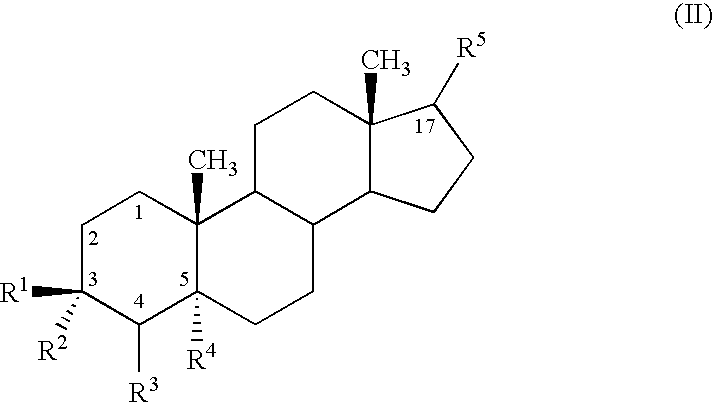Use of neurosteroids to treat neuropathic pain
a neurosteroid and pain technology, applied in the field of treating neuropathic pain, can solve the problems of withdrawal from activity, difficult control of neuropathic pain, surgical destruction of nerves,
- Summary
- Abstract
- Description
- Claims
- Application Information
AI Technical Summary
Benefits of technology
Problems solved by technology
Method used
Image
Examples
example 1
Synthesis of Ganaxolone
[0053] Ganaxolone (3α-hydroxy-3β-methyl-5α-pregnan-20-one) is synthesized as described in U.S. Pat. No. 3,953,429, incorporated herein by reference, or in Hogenkamp, et. al. J. Med. Chem. 40:61-72, 1997 also incorporated herein by reference. In brief, a mixture of sodium hydride (17 mg.), trimethyl-sulphoxonium iodide (300 mg.) and dimethyl sulphoxide (2 ml.) is stirred under nitrogen at room temperature for 1 hr. 5α-pregnane-3,20-dione-20-ketal (3 g), is then added and the resulting mixture is stirred for a further 2 hr. and poured into water. The precipitated solid is collected by filtration, washed with water and dried over P2O5 in vacuo. Recrystallisation from acetone / petrol gives 3(R)-20,20-ethylenedioxy-5α-pregnane-3-spiro-2′-oxirane, as white needles.
[0054] A solution of the above 3(R)-20,20-ethylenedioxy-5α-pregnane-3-spiro-2′-oxirane in tetrahydrofuran (5 ml.) is added to a stirred suspension of lithium aluminium hydride (0.5 g.) in ether (15 ml.). ...
example 2
Cold Allodynia in Chronic Constriction Injury Model
[0056] Unilateral sciatic nerve injury was produced under deep anesthesia with i.p injection of sodium pentobarbital (Mebumal, 60 mg / kg), as described by Bennett and Xie (Pain, 33, 87-107(1988)). The common sciatic nerve was exposed and freed for about 10 mm at mid-thigh level. Four ligatures (Ethicon, 4.0 plain gut) were tied loosely around the nerve with about 1-mm spacing creating a chronic constriction injury (CCl), and the incision was closed.
[0057] Brisk foot withdrawal in response to acetone application was measured based on the method described by Choi et al. The acetone bubble was gently brought in touch with the plantar surface around the center, and the acetone quickly spread over the central part of the plantar surface of the foot. Applications were made five times (once every 5 min) to each paw. The score for each application was recorded as follows: foot withdrawal was scored as positive (1) and lack of withdrawal as...
example 3
(A) Tactile and (B) Thermal Allodynia in Spinal Nerve Ligation Model
[0060] (A) L5 / L6 spinal nerve ligation (SNL) was performed as described by Kim and Chung (Pain, 50,355-363(1992)). Animals (mice or rats) were anesthetized with halothane. An incision was made lateral to the lumbar spine. The right L5 and L6 spinal nerves were isolated and tightly ligated distal to the dorsal root ganglion. The incision was closed, and animals were allowed to recover for 10 days. Sham-operated animals were prepared in an identical fashion except that the spinal nerves were not ligated.
[0061] Tactile withdrawal threshold was determined as described by Chaplan et al (J. Neurosci. Methods, 53,55-63 (1994). Animals were acclimated for 30 min in suspended cages with wire mesh bottoms. The hindpaw was probed with calibrated von Frey filaments (Stoelting) applied perpendicularly to the plantar surface. A positive response was indicated by a sharp withdrawal of the paw. The 50% paw withdrawal threshold wa...
PUM
 Login to View More
Login to View More Abstract
Description
Claims
Application Information
 Login to View More
Login to View More - R&D
- Intellectual Property
- Life Sciences
- Materials
- Tech Scout
- Unparalleled Data Quality
- Higher Quality Content
- 60% Fewer Hallucinations
Browse by: Latest US Patents, China's latest patents, Technical Efficacy Thesaurus, Application Domain, Technology Topic, Popular Technical Reports.
© 2025 PatSnap. All rights reserved.Legal|Privacy policy|Modern Slavery Act Transparency Statement|Sitemap|About US| Contact US: help@patsnap.com



